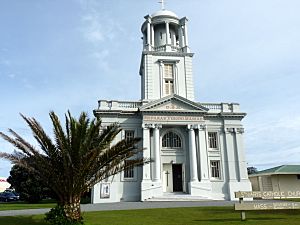St Mary's Catholic Church, Hokitika facts for kids
Quick facts for kids St Mary's Catholic Church |
|
|---|---|
 |
|
| 42°42′58″S 170°57′54″E / 42.71606°S 170.96502°E | |
| Location | 71 Sewell Street, Hokitika |
| Country | New Zealand |
| Denomination | Catholic |
| History | |
| Status | Parish church |
| Architecture | |
| Functional status | Closed to the public |
| Architect(s) | Sidney and Alfred Luttrell |
| Architectural type | Neoclassical |
| Groundbreaking | 1914 |
| Completed | 1928 |
| Specifications | |
| Materials | Plastered brick |
| Administration | |
| Parish | Hokitika St Mary's |
| Archdiocese | Wellington |
| Diocese | Christchurch |
St Mary's Catholic Church is a beautiful old church located in Hokitika, New Zealand. It's a special Catholic building and a well-known landmark on New Zealand's West Coast.
Contents
History of St Mary's Church
Early Days of the Church
Many Irish Catholic people, often miners, came to the West Coast long ago. They were looking for natural resources like gold. Because of this, a large part of the area's population was Catholic.
In the town's early plans, a special area of about 2.5 acres (1 hectare) was set aside for the Catholic community. This land was located between Tancred, Stafford, and Sewell streets.
The first church buildings were built here in 1865. They were named after Saint Mary, who is the church's patron saint. A patron saint is like a special protector or guide for a place or group of people. The first church quickly became too small, so a new one was built in 1866. By 1912, this second church was also getting old and needed a lot of repairs.
Planning a New Church
On July 15, 1912, the church committee decided it was time for a brand new building. They asked architects to submit ideas and plans for a new church.
John Thomas Watson, an architect from Greymouth, created an early design. He chose a Neoclassical style, which was different from the Gothic architecture that was popular before. This new style was inspired by the Christchurch Basilica, a large church that had been finished in 1905.
Alfred Luttrell, from the famous Luttrell brothers architectural firm, won the job to design and build the church. The Luttrells used Watson's ideas but also added many of their own unique touches.
Building the Church
Construction Begins
The old 1866 church was taken down in February 1914. Bishop John Grimes placed the first foundation stone for the new church on March 23, 1914. The new building was constructed on the same spot as the old one. However, its main entrance now faced Sewell Street instead of Tancred Street.
The main part of the church, called the nave, was ready for use by Christmas Eve in 1914.
Finishing Touches
Building the church took a long time because of World War I and problems getting enough money. It wasn't until 1920–21 that the front porch, called the portico, and the tall tower were added.
The portico has a special Latin phrase carved on it: Deiparae Virgini Mariae. This means "Mother Virgin Mary." It also has the letters D.O.M., which stands for another Latin phrase, Deo optimo maximo. This means "to the greatest and best God."
Inside, the church is simpler than its outside. This was common for other Neoclassical churches built in Canterbury around the same time. The interior has a large organ and a choir loft that hangs over the main seating area.
The church was built with double brick walls. However, it wasn't until 1927 and 1928 that plaster was put on the outside. This gave the church its final, finished look.
Current Status
St Mary's Catholic Church belongs to the Roman Catholic Diocese of Christchurch. In 2004, it was officially recognized as a very important historical building. The New Zealand Historic Places Trust (now called Heritage New Zealand) gave it a Category I status. Its registration number is 1705.
In June 2012, the church was closed to the public. This happened after a check of its structure, which was done because of the 2011 Christchurch earthquake that happened in February 2011.
Images for kids
See also
 In Spanish: Iglesia de Santa María (Hokitika) para niños
In Spanish: Iglesia de Santa María (Hokitika) para niños








